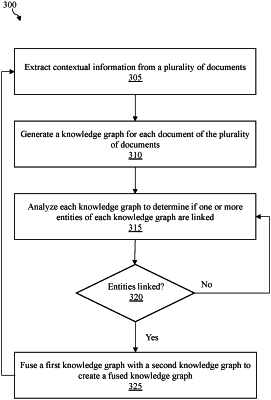| CPC G06F 40/295 (2020.01) [G06F 16/9024 (2019.01); G06N 5/02 (2013.01); G06N 20/00 (2019.01)] | 13 Claims |

|
1. A computer-implemented method comprising:
extracting contextual information from a plurality of documents;
generating, based on the extracted contextual information, a knowledge graph for each document of the plurality of documents;
analyzing each knowledge graph to determine if one or more entities of each knowledge graph are linked, wherein the analyzing comprises:
determining a set of textual mentions related to each of the one or more entities of each knowledge graph; and
mapping one or more textual mentions from the set of textual mentions related to each of the one or more entities to a same or a similar entity in a different knowledge graph based on a similarity score, wherein the similarity score is weighted based, in part, on one or more reliability characteristics of a source of each document of the plurality of documents;
fusing, in response to an entity in a first knowledge graph being linked to an entity in a second knowledge graph, the first knowledge graph with the second knowledge graph to create a fused knowledge graph;
receiving a first natural language query (NLQ) from a user regarding the one or more entities;
outputting, using the fused knowledge graph, an answer to the first NLQ;
receiving a second NLQ from the same user, wherein the second NLQ is substantially similar to the first NLQ;
determining, based on the second NLQ being substantially similar to the first NLQ, that an accuracy value of the answer to the first NLQ is low;
analyzing, using machine learning, the accuracy value of the answer to the first NLQ that was provided using the fused knowledge graph; and
modifying, using machine learning and based on the low accuracy value for the answer, algorithms for traversing the fused knowledge graph to obtain a higher accuracy value when providing a replacement answer.
|